Grade Crossings
Grade crossings in the urban area come in a wide variety of sizes and designs, from simple pedestrian paths across a single track, to major roadways crossing multi-track lines. Some of the latter are often closed more than they are open at peak times, and the usual fix is to elevate the entire railway line (which is neither cheap, nor easy), which has been done recently on several lines around Tōkyō. But that’s not always practical, and in some places it’s not really necessary, so many grade crossings remain.
Vehicular Crossings
A typical grade crossing occurs where a road (and sidewalks) crosses train track(s) “at grade”. Both vehicles and pedestrians have to be kept of the tracks when trains are approaching. And with the high number of trains in Tōkyō, most crossings are equipped so that a vehicle stuck on the tracks will alert the train before a crash occurs. There are also manual warning buttons to do the same (only in Japan could you put a button like that next to a sidewalk and not have some prankster stopping every train).
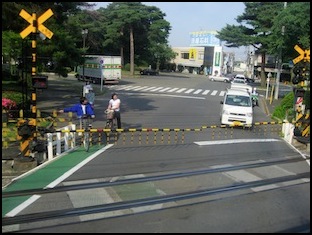
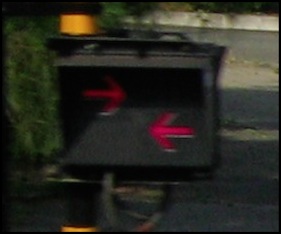
Kodaira Station crossing (2007) and detail of train direction indicator
Location: Kodaira, Tōkyō
Photographer: abuckingham (both)
This grade crossing illustrates a typical arrangement. Note the crossbucks on both sides of the street, the green-painted pedestrian area (with white border), and the two half-poles, one from each side of the crossing. The warning sign with the red arrows lights to indicate the direction of travel of an approaching train (or trains). Also note that on the crossbuck on the right, the two circular lights are mounted vertically, rather than on either side of the pole, due to space limitations. These poles are decorated with short streamers to make them more visible, but that’s a detail that’s not always present.
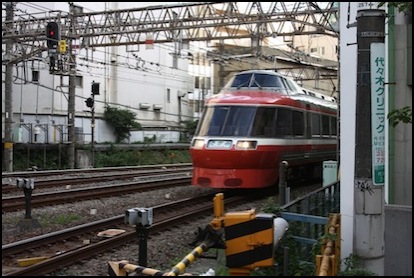
Crossing Sensors (2011)
Location: near Shinjuku Station, Shinjuku, Tōkyō
Photographer: afcowie
This photo illustrates the sensors used to detect vehicles. The silver boxes on posts contain lights and photosensors, and an obstruction on the track taller than someone’s pet cat will block the beam and light a signal to warn the drivers of approaching trains. This is a type of “obstruction signal” (also used in stations and other places where things or people can get on the tracks).
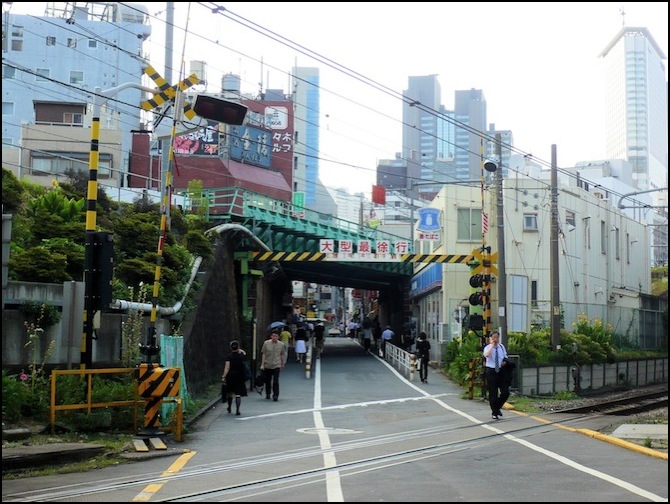
Shinjuku crossing (2008)
Location: Shinjuku, Tōkyō
Photographer: Stéfan
Another grade crossing, this one with the left crossbuck and lights on a cantilevered pole. On the right (and on the left facing away from the camera) the warning lights are again vertical. On this crossing, the pedestrian areas aren’t specially painted, but there is a yellow border away from the street, and the usual while boarder towards the street. The horizontal yellow/black bar isn’t part of the grade crossing, but a clearance warning, apparently protecting the bridge in this case, although you sometimes see these on grade crossings to prevent overheight vehicles from snagging the wires.
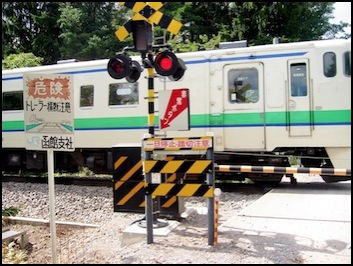
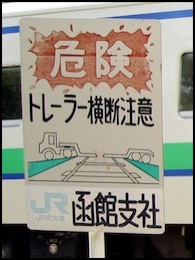
Onuma crossing (2004) and sign detail
Location: Onuma, Hokkaido
Photographer: Quosquos (both)
Although not in Tōkyō, but rather the northern island of Hokkaido. This crossing is somewhat simpler, but has many of the same features found elsewhere. It’s particularly notable for the JR sign (detail) warning trucks that they could become stuck because the roadway across the tracks is higher than the road to either side. The big red arrow sign probably points to the obstruction-warning switch.
Pedestrian Crossings
Not all grade crossings are for vehicles. Footpaths and other pedestrian rights-of-way often need to cross tracks, and in places with high volumes of traffic this requires protection very similar to that found at vehicular crossings, including gates.
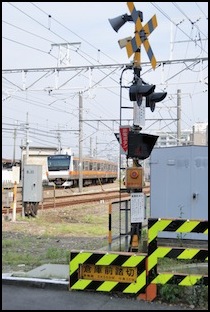
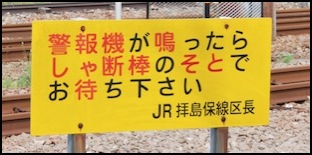
Longest Crossing in the World (2009) and warning sign
Location: Photographer: Akishima City, Tōkyō
Photographer: ykanazawa1999 (both)
The “longest crossing in the world” is a pedestrian crossing 130 meters long over 11 tracks of the JR East Ōme and Hachikō lines, and the Seibu Haijima lines at Hajima Station. It closed in 2009. The photo above illustrates a typical marker, with (top to bottom): a speaker for the audible signal, crossbucks, red lights that flash to warn of oncoming trains, another set of lights that show direction (black object seen from side), and emergency button (orange circle under the red arrow) to activate the obstruction warning signal to the train, various signs, and a brightly-painted guardrail to protect the equipment from vehicles. A ladder provides access to the lights, and nearby electrical cabinets contain the equipment that drives the signals. Not visible in this photo is the pole that blocks the crossing.
The warning sign says: “When the Warning Bell Sounds, Wait Outside of the Bar”. All sorts of drunk-commuter jokes come to mind...
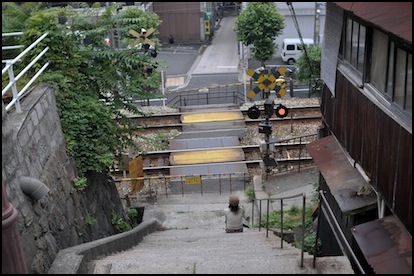
Hiroshima crossing (2008)
Location: Hiroshima
Photographer: Harasho
(Note: the original for this image is no longer online)
Although not in Tōkyō, this crossing nicely illustrates how complex even a small pedestrian crossing can be, with all the usual lights, poles, and signs. Note the sign on the left which, among other things, indicates that it’s 4.5 meters to cross the tracks. This seems less important here than it would be on a longer crossing.
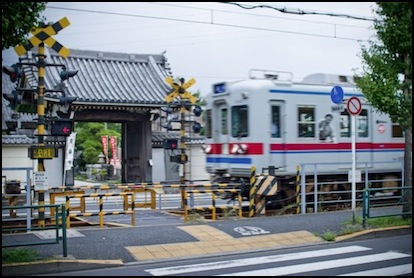
Keisei Kanamachi (2008)
Location: Shibamata, Tōkyō
Photographer: haribote
Here the Keisei Kanamachi line runs past a temple entrance, which at times can have heavy foot traffic. A direct crossing of the tracks is required, and again is secured by gates, and both warning and directional lights.




